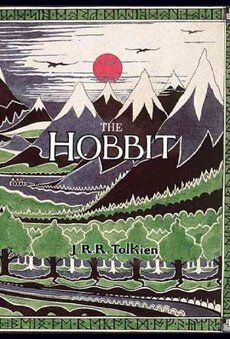
In Middle-Earth, a world full of wizards and humans, dwarves and elves, and many darker creatures who dwell in the shadows where none but evil dare to tread, there is one race not troubled with light and dark or terrible wars. The hobbits of the Shire live peacefully in their round-doored hobbit-holes, enjoying uneventful serenity, with an emphasis on frequent, delicious meals. They are not the types to go on adventures or gallivant about with dwarves or wizards. And especially not hobbits from a family so respectable, so down-to-earth, as the Bagginses.
Yet when the wizard Gandalf and thirteen dwarves appear at Bilbo Baggins’ front door one afternoon, he finds himself caught up in a strange business which can only be described as an adventure. Long ago, the dragon Smaug descended from the north and destroyed the halls ruled by the dwarf Thorin’s forefathers, Lonely Mountain, a place once full of numberless riches and excellent craftmanship. Now, it is a tomb to the dead, and Smaug sits atop the dwarves’ ancestral gold. The dwarves, led by Thorin Oakenshield, have planned a dangerous quest: to slay the dragon and, at last, win back what once was theirs. And they wish for Bilbo Baggins to be the final member of their company.
Despite his initial misgivings, Bilbo accompanies the dwarves and Gandalf on the journey to Lonely Mountain. The path is long and perilous, crossing dangerous mountains, vast plains, a forest darkened by shadowy beasts, and at last the desolation of Smaug which surrounds the mountain itself.
Hobbits have never been a people for adventuring. But perhaps Bilbo will be the crucial piece in the journey to Lonely Mountain.
I find myself now rereading The Hobbit, and I can see quite clearly why it is such a fantasy classic. J. R. R. Tolkien’s story is not only full of danger and adventure, but also spots of humor, interesting characters, and excellent writing. Although this book is more sedately paced than more modern fantasy novels, it isn’t less engaging, as it is often seen as; instead, it is simply written in a different style.
As someone who loves excellent worldbuilding, Middle-Earth is high on my list. The lands this book travels through are distinct and multilayered, as are the creatures who dwell there. Each race—mainly humans, hobbits, dwarves, and elves—is distinct and well-defined. Tolkien clearly knew this universe very well, including its history; to those who love distinct fantasy worlds, I also highly recommend The Silmarillion, a prequel Tolkien wrote concerning the history of Middle-Earth. Tolkien’s novels of Middle-Earth are some of my favorites. I highly recommend The Hobbit to readers ages ten and up.



 RSS Feed
RSS Feed
